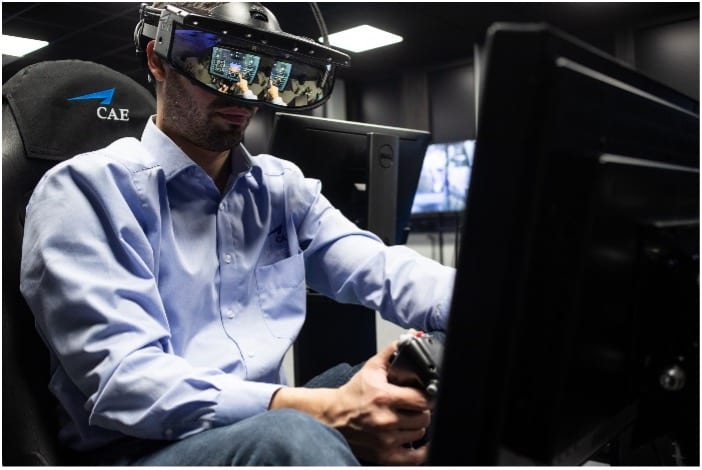Air Taxi Manufacturers Need to Start Thinking About Pilot Training Now


Experts in the industry are warning that air taxi manufacturers need to start creating pilot training programs now in order to meet planned commercial launches in the next three or four years. (CAE)
There is a consensus in the electric air taxi industry that the first aircraft to emerge in the commercial world will not be autonomous. This begs the question, who will fly them, and what kind of training will these pilots need to fly these new aircraft?
Experts in the industry are warning that air taxi manufacturers need to start creating pilot training programs now in order to meet planned commercial launches in the next three to four years.
“It’s really, really important, if the OEMs, want to get their aircraft into service on time, that they’re thinking about this training piece, two to three years out is what we’re suggesting right now,” Christopher Courtney, director of advanced air mobility at CAE, said during a call with reporters on July 7. “We have been doing this for a very long time, so we know what it takes to get there and the last thing you want is a cool we’re getting closer and closer and now we’ve got to figure out how to develop a simulator training program…and it’s going to cause delays.”
CAE and Volocopter announced a new partnership to develop a pilot training program for Volocopter’s electric vertical takeoff and landing (eVTOL) aircraft on July 8. Volocopter is planning to launch its VoloCity eVTOL at the Olympics in Paris in 2024, according to the release. As part of the agreement, CAE will invest $40 million to meet Volocopter’s projected global pilot demand.
“As we scale our UAM services in cities around the world, specific pilot training and qualification for our Volocopters will be an important element. We are proud to be partnering with CAE, who have a track record in developing best-in-class, innovative pilot training solutions for new aircraft programs. It will greatly benefit Volocopter’s entry-into-service timeline and scale,” Florian Reuter, CEO of Volocopter, said in a statement. “We are excited about CAE’s endorsement and look forward to collaborate as partners focused on combining future-oriented technologies to ensure aviation safety.”
Air taxi missions will present unique operating environments for pilots, Timothy Schoenauer, director of global training solutions BAT/HAT at CAE said during the July 7 call. The missions will generally be shorter and in more congested air space within urban environments. These factors will contribute to training challenges such as the currently undefined regulatory requirements for eVTOL pilots and single-pilot operations.
Schoenauer said CAE is focusing on training pilots around pilot competencies rather than prescriptive models with a Competency Based Training Assessment (CBTA) approach.

Air taxi missions will present unique operating environments for pilots, Timothy Schoenauer, director of global training solutions BAT/HAT at CAE said during the July 7 call. (CAE)
“CBTA is the process that we plan to follow for eVTOL training program development and the main reason why is that it’s an internationally recognized process that allows us to write a training program once instead of several times for different entities around the world,” Schoenauer said.
This approach is international and will provide companies with the benefit of not having to create training programs for each civil aviation authorities’ rules, Schoenauer said.
CBTA is based on nine pilot competencies including problem-solving, decision making, situational awareness, workload management, and teamwork, Schoenauer said. This program also places a large focus on gathering pilot data and analyzing it to determine the effectiveness of the training and revise the program if necessary.
CAE is building a pathway to regulatory compliance with a seven-step model to determine which devices need to be used during training and the structure of the program. The steps include: data and science, leveraging a standard and determining what applies, documenting the difference, determining the best way to train tasks, a risk assessment, developing industry consensus standards, and then continuous improvement. According to CAE, they have already completed step one of this pathway with vehicle partners.
“I think what we recognize is foundational training needs analysis needs to be done first and that’s the foundational piece that will build the entire training program,” Courtney said.
To add to these challenges, eVTOL companies will need an influx of approximately 60,000 pilots by 2028, according to research from CAE, in an industry that is already headed towards a pilot shortage, Schoenauer said.
Courtney said he estimates that every aircraft will need about three pilots to operate.
“To support that level of operation, and just knowing how many hours and how many days a pilot can work, the math would lead you to believe that you need about three pilots for every aircraft, for the most part, to fly at the rates that a lot of the OEMs are publicly talking about,” Courtney said. “So, between two and three pilots, you plan for that, and just based on an aircraft number that’s coming out, you can start to do the math and you could start to see where the numbers start to become exponential. As the production rates increase, as we all know with these novel aircraft…is that they’re partnering up with automobile manufacturers and folks that can really accelerate the production aircraft and so you can see as I produce a lot of aircraft, you’re going to need more pilots.”
CAE is also currently working with Jaunt Air Mobility to develop a simulation lab for Jaunt’s eVTOL aircraft.
The post Air Taxi Manufacturers Need to Start Thinking About Pilot Training Now appeared first on Aviation Today.
Check FastApn access for commercial satcoms at Fastapn
Flytlink – Avionics, Satcom’s and IFE Consultants






